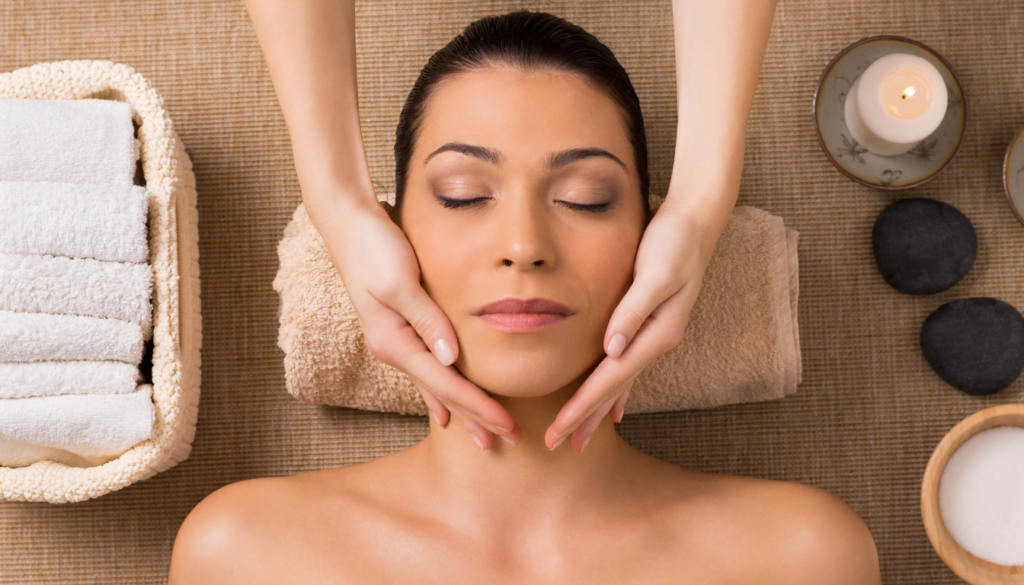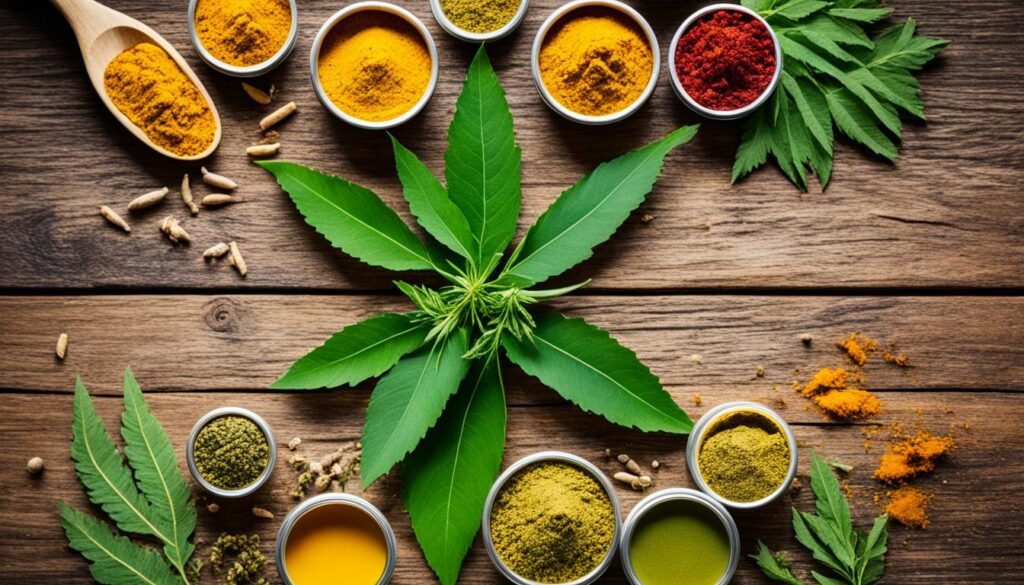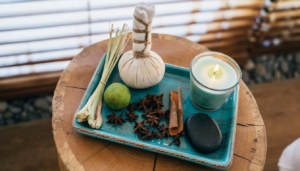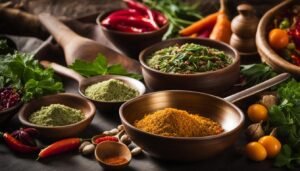Welcome to my guide on Ayurvedic skin care recipes! If you’re looking for a natural and holistic approach to achieving a radiant and glowing complexion, you’ve come to the right place. In this article, I will share with you the power of Ayurveda and how you can create your own homemade skin care remedies using herbal ingredients and traditional Ayurvedic practices.
Ayurvedic beauty treatments have been used for centuries to nourish and rejuvenate the skin. By incorporating these recipes into your skincare routine, you can customize an Ayurvedic skin care regimen that is tailored to your specific skin type and concerns. Whether you have dry skin, sensitive skin, or oily skin, there’s an Ayurvedic solution for you.

Discover the power of natural skincare with Ayurveda and unveil the secrets of holistic skincare. From homemade masks to rejuvenating oils, there are plenty of Ayurvedic remedies that can transform your skin and promote a healthy, radiant glow. So, let’s dive into the world of Ayurveda and discover the beauty of herbal skincare!
Table of Contents
Key Takeaways:
- Ayurvedic skin care recipes offer a natural and holistic approach to achieving a radiant complexion.
- These recipes utilize herbal ingredients and traditional Ayurvedic practices to nourish and rejuvenate the skin.
- By following an Ayurvedic skin care routine, you can address specific skin concerns and promote overall well-being.
- Ayurvedic beauty treatments can be customized to fit your specific skin type and concerns.
- Explore the power of DIY skincare with Ayurvedic ingredients and create personalized remedies for your skin.
Ayurvedic Skin care Recipes for Vata Skin
Vata skin is characterized by dryness, thinness, and sensitivity. It is prone to premature aging and requires gentle care to maintain its natural glow. Ayurvedic skincare recipes for vata skin focus on nourishing and moisturizing the skin.
When it comes to dry skincare, ingredients like almond oil, lavender essential oil, and chamomile essential oil are highly beneficial. Almond oil is deeply hydrating and rich in vitamins and antioxidants, which help nourish and rejuvenate the skin. Lavender essential oil has soothing properties that help relieve dryness and calm irritated skin. Chamomile essential oil is known for its anti-inflammatory properties, which can help reduce redness and promote a youthful complexion.
Ayurvedic Skin care Recipes for Vata Skin
Here are some ayurvedic skin care recipes specifically designed for vata skin:
- Almond and Honey Face Mask: Mix 2 tablespoons of almond oil with 1 tablespoon of honey. Apply the mixture to your face and leave it on for 15-20 minutes before rinsing off. This mask deeply nourishes and moisturizes vata skin, leaving it soft and supple.
- Lavender and Rose Water Toner: Mix 1 tablespoon of lavender essential oil with 2 tablespoons of rose water. Apply this toner to your face using a cotton pad after cleansing. It helps soothe and hydrate the skin, reducing dryness and promoting a healthy complexion.
- Chamomile and Aloe Vera Gel Moisturizer: Mix 2-3 drops of chamomile essential oil with 1 tablespoon of aloe vera gel. Massage this moisturizer onto your face and neck, focusing on dry areas. Chamomile helps calm and soothe the skin, while aloe vera gel provides deep hydration.
By incorporating these ayurvedic skin care recipes into your routine, you can effectively address the needs of vata skin and achieve a nourished, moisturized, and youthful complexion.

Continue reading to discover specialized ayurvedic skin care routines for pitta and kapha skin types.
Ayurvedic Skin care for Pitta Skin
Pitta skin is characterized by sensitivity, fair complexion, and a tendency towards redness and inflammation. It requires gentle care and special attention to maintain its balance and radiance. Ayurvedic skincare recipes for pitta skin are designed to soothe and calm the skin, while providing essential nourishment. These recipes utilize natural ingredients known for their cooling and soothing properties, helping to reduce redness, inflammation, and skin irritations.
To effectively care for pitta skin, it is important to prioritize sensitive skin care and incorporate sun protection into your daily routine. This helps to prevent sun damage, which can exacerbate the sensitivity and inflammation associated with pitta skin. Ayurvedic skin care recipes for pitta skin often include ingredients that provide a protective barrier against the harmful effects of the sun.
Here are some key ingredients used in ayurvedic skin care for pitta skin:
- Lentil Flour: Lentil flour is known for its cooling and soothing properties. It helps to reduce redness and inflammation, making it ideal for pitta skin care recipes.
- Neem Powder: Neem powder has antimicrobial and anti-inflammatory properties, making it beneficial for sensitive and acne-prone skin. It helps to calm and purify the skin, reducing breakouts and preventing further irritation.
- Jojoba Oil: Jojoba oil closely resembles the natural oils produced by the skin, making it an excellent choice for pitta skin. It moisturizes and balances the skin without clogging pores, providing nourishment and hydration.
- Geranium Essential Oil: Geranium essential oil has soothing and cooling properties, making it suitable for pitta skin care. It helps to balance sebum production, reduce inflammation, and promote overall skin health.
Importance of Sun Protection for Pitta Skin
Protecting your skin from the harmful effects of the sun is crucial for pitta skin care. Sun exposure can worsen redness, inflammation, and sensitivity in pitta skin, leading to long-term damage. Incorporating sun protection into your daily routine helps to prevent sunburn, premature aging, and the development of skin conditions.
An effective way to protect pitta skin from the sun is by using Ayurvedic sunscreen recipes. These recipes often include natural ingredients with sun-protective properties, such as:
- Sandalwood Powder: Sandalwood powder has cooling and soothing properties, making it suitable for pitta skin. It also acts as a natural sunscreen, protecting the skin from harmful UVA and UVB rays.
- Aloe Vera Gel: Aloe vera gel is known for its soothing and healing properties. It also contains natural sun protection factors, making it an excellent ingredient in sunscreens for pitta skin.
- Coconut Oil: Coconut oil has natural SPF properties and can act as a protective barrier against the sun. It also moisturizes and nourishes the skin, preventing dehydration caused by sun exposure.
By incorporating these sun-protective ingredients into your skincare routine, you can help shield your pitta skin from the damaging effects of the sun while maintaining its health and radiance.
| Ingredients | Benefits |
|---|---|
| Lentil Flour | Reduces redness and inflammation |
| Neem Powder | Cleanses and purifies the skin |
| Jojoba Oil | Moisturizes and balances the skin |
| Geranium Essential Oil | Soothes and calms the skin |
Ayurvedic Skin care for Kapha Skin
Kapha skin is characterized by oiliness, thickness, and a tendency towards congestion and blemishes. When it comes to skincare for kapha skin, deep cleansing and balancing excess oil production are the key goals. Utilizing Ayurvedic skincare recipes can help address these specific concerns and promote a clear and healthy complexion.
Here are some essential ingredients and techniques to incorporate into your kapha skincare routine:
Deep Cleansing:
To combat oiliness and congestion, it is crucial to incorporate deep cleansing practices. Ayurvedic recipes recommend using honey, lemon juice, and herbs with astringent properties for effective deep cleansing. The natural antibacterial and antimicrobial properties of honey help cleanse the skin while hydrating it. Lemon juice acts as a natural astringent, reducing excess oil and tightening the pores, leaving the skin refreshed and toned.
Nourishing and Oil-balancing:
In addition to deep cleansing, it is important to nourish and balance the skin’s natural oil production. Sesame oil is highly recommended in Ayurveda for kapha skin due to its ability to penetrate deep into the skin and balance sebum production. Lemongrass essential oil can also be added to your skincare routine to reduce oiliness and prevent the clogging of pores.
“Once you find the right balance between cleansing and nourishing, your kapha skin will thank you with a clear and healthy complexion.”
DIY Ayurvedic Skin care Recipes for Kapha Skin:
Here’s a simple DIY recipe for deep cleansing and oil-balancing mask for kapha skin:
| Ingredients | Method |
|---|---|
| Honey | 1 tablespoon |
| Lemon Juice | 1 teaspoon |
| Sesame Oil | 1 teaspoon |
| Lemongrass Essential Oil | 3-4 drops |
| Combine all the ingredients in a small bowl and mix well. | Apply the mixture to your cleansed face, avoiding the eye area. |
| Leave it on for 10-15 minutes, allowing it to deeply cleanse and balance the skin. | Rinse off with warm water and pat dry. |
| Follow with a moisturizer suitable for kapha skin. | Use this mask once or twice a week for optimal results. |
The combination of honey, lemon juice, sesame oil, and lemongrass essential oil in this DIY mask will help cleanse, nourish, and control sebum production, promoting a clear and healthy complexion for kapha skin.

Natural Ingredients for Ayurvedic Skin care
Ayurvedic skincare emphasizes the use of natural ingredients that are easily accessible in your kitchen. These kitchen ingredients hold a treasure trove of benefits for your skin, providing nourishment, hydration, and rejuvenation. Incorporating these natural ingredients into your skincare routine can enhance the effectiveness of your Ayurvedic skincare recipes and promote a healthy, vibrant complexion.
Kitchen Ingredients for Skincare:
- Lime juice: Lime juice is packed with vitamin C, which helps brighten the skin and reduce dark spots.
- Orange juice: The high content of vitamin C in orange juice promotes collagen production, making your skin supple and youthful.
- Watermelon juice: Watermelon juice is rich in antioxidants and hydrating properties, making it ideal for moisturizing and refreshing the skin.
- Tomato juice: Tomato juice contains lycopene, which protects the skin from sun damage and helps in reducing signs of aging.
- Almond paste: Almond paste is known for its nourishing properties, providing deep moisturization and improving skin texture.
- Cucumbers: Cucumbers have a cooling effect on the skin and are known for their hydrating and soothing properties.
- Oatmeal: Oatmeal acts as a gentle exfoliator, removing dead skin cells and leaving your skin smooth and radiant.
- Potatoes: Potatoes have natural bleaching properties that can help lighten dark spots and blemishes.
- Avocados: Avocados are rich in healthy fats that moisturize and nourish the skin, leaving it soft and supple.
By incorporating these herbal remedies for skin into your Ayurvedic skin care routine, you can harness the power of nature to achieve healthy, glowing skin.

Rejuvenating Homemade Skincare Ingredients:
| Natural Ingredient | Benefits |
|---|---|
| Almond paste | Moisturizes and improves skin texture |
| Watermelon juice | Hydrates and refreshes the skin |
| Lime juice | Brightens the skin and reduces dark spots |
| Cucumbers | Provides a cooling effect and soothes the skin |
| Oatmeal | Gently exfoliates and reveals radiant skin |
| Potatoes | Lightens dark spots and blemishes |
With these natural ingredients at your disposal, you can create homemade skincare recipes that are safe, effective, and tailored to your skin’s needs. Say goodbye to harmful chemicals and embrace the power of nature for a healthier, more radiant complexion.
Step-by-Step Ayurvedic Skin care Protocol
Following a step-by-step skincare protocol is essential to achieve optimal results with Ayurvedic skincare. By incorporating specific Ayurvedic techniques and recipes into your daily routine, you can create a holistic skincare ritual that promotes a natural glow and overall well-being.
Here are the key steps of an effective Ayurvedic skincare protocol:

Exfoliating: Exfoliation is an important step to remove dead skin cells and reveal a smoother complexion. Use an Ayurvedic scrub or exfoliant to gently massage your face, promoting circulation and cellular renewal.
Moisturizing: Hydrate and nourish your skin with an Ayurvedic moisturizer or facial oil. Choose a product that suits your skin type and concerns, such as dryness, oiliness, or anti-aging. Massage the moisturizer into your skin using gentle upward strokes, promoting absorption and collagen production.
Ayurvedic Self-Massage: Self-massage, also known as Abhyanga, is a self-care practice that involves massaging the body with warm oil to promote relaxation and rejuvenation. Choose an Ayurvedic oil suitable for your dosha (Vata, Pitta, or Kapha), and massage it into your skin using circular motions. This practice helps improve blood circulation, lymphatic drainage, and skin elasticity.
Skincare Steps Summary: Here is a summary of the steps for your Ayurvedic skin care routine:
| Step | Description |
| 1 | Cleansing |
| 2 | Exfoliating |
| 3 | Moisturizing |
| 4 | Ayurvedic Self-Massage |
In addition to these skincare steps, it is important to maintain a restful sleep schedule, as sleep is vital for skin rejuvenation and overall well-being. By following this Ayurvedic skincare protocol and incorporating self-care beauty practices into your routine, you can enhance your natural beauty and promote a healthy, radiant complexion.
Do-It-Yourself Ayurvedic Beauty Recipes
Incorporating DIY Ayurvedic beauty recipes into your skincare routine allows you to harness the power of natural and herbal ingredients. These homemade skincare recipes offer effective solutions for achieving healthy and radiant skin. In this section, I’ll share two popular DIY Ayurvedic beauty recipes: a rose-turmeric facial scrub and an ayurvedic facial oil.
Rose-Turmeric Facial Scrub
To exfoliate and nourish your skin, try this rejuvenating rose-turmeric facial scrub. The ingredients in this recipe work together to remove dead skin cells, promote a youthful complexion, and enhance your skin’s natural glow. Here’s how to make it:
- Combine 2 tablespoons of chickpea flour, 1 tablespoon of almond powder, 1 tablespoon of rose petal powder, and ½ teaspoon of turmeric in a bowl.
- Add enough water or rose water to form a paste-like consistency.
- Gently massage the scrub onto your damp face using circular motions, avoiding the delicate eye area.
- Rinse off with lukewarm water and pat your skin dry.
This rose-turmeric facial scrub provides gentle exfoliation, while the natural ingredients nourish your skin, leaving it soft, smooth, and radiant.
Ayurvedic Facial Oil
An ayurvedic facial oil is a great addition to your skincare routine, providing deep hydration and promoting youthful-looking skin. This DIY recipe combines nourishing oils with aromatic essential oils to create a luxurious facial oil. Here’s how to make it:
- In a small glass bottle, mix 2 tablespoons of jojoba oil, 1 tablespoon of almond oil, and ½ teaspoon of vitamin E oil.
- Add 5 drops of rose otto essential oil for its anti-aging properties and a delightful floral scent.
- For a grounding aroma, add 3 drops of khus or geranium essential oil.
- Secure the bottle with a cap and shake well to blend the oils.
- Apply a few drops of the facial oil to clean, dry skin after cleansing and toning.
- Gently massage the oil into your face and neck using upward strokes.
This ayurvedic facial oil deeply nourishes and moisturizes the skin, helping to reduce the appearance of fine lines and promoting a youthful complexion.

Ayurvedic Beauty Recipes
These DIY Ayurvedic beauty recipes are cost-effective and customizable, allowing you to tailor your skincare routine to meet your specific needs.
Ayurvedic Skin care Routine for Glowing Skin
An Ayurvedic skincare routine is a holistic approach that promotes radiant and healthy skin from the inside out. By incorporating both external and internal practices into your daily self-care regimen, you can enhance the natural glow of your skin and promote overall well-being.
External Skincare Practices: Cleansing, Nourishing, and Moisturizing
External skincare practices are essential for maintaining the health and radiance of your skin. Follow these Ayurvedic techniques and recipes to cleanse, nourish, and moisturize your skin:
- Cleansing: Use gentle and natural cleansers that do not strip away the skin’s natural oils. Ayurvedic ingredients like rose water, sandalwood powder, and turmeric can effectively cleanse the skin while keeping it balanced and refreshed.
- Nourishing: Provide your skin with nourishment using herbal facial masks and packs. Ingredients like aloe vera gel, neem paste, and honey can deeply nourish the skin, leaving it soft, supple, and radiant.
- Moisturizing: Hydrate and moisturize your skin using Ayurvedic oils and creams. Opt for ingredients like almond oil, coconut oil, and shea butter, which deeply penetrate the skin and lock in moisture for a youthful and glowing complexion.
Internal Skincare Practices: Healthy Lifestyle Habits
Internal skincare practices focus on maintaining a healthy lifestyle to support the health and radiance of your skin. Incorporate the following habits into your daily routine:
- Healthy Diet: Follow a balanced diet rich in fruits, vegetables, whole grains, and lean proteins. Include Ayurvedic superfoods like turmeric, cumin, and ginger to enhance your skin’s vitality.
- Regular Exercise: Engage in regular physical activity to boost blood circulation and promote a healthy glow. Activities like yoga, brisk walking, and dance can improve the overall health and appearance of your skin.
- Restful Sleep: Ensure you get an adequate amount of sleep every night to allow your skin to repair and regenerate. Create a soothing bedtime routine that includes relaxing activities like reading, meditation, or taking a warm bath.
- Yoga and Pranayama: Practice yoga asanas and pranayama techniques that specifically target the health of your skin. Poses like Sarvangasana (shoulder stand) and breathing exercises like Kapalabhati (skull shining breath) can improve blood circulation and bring a natural glow to your skin.
- Meditation: Dedicate a few minutes each day to meditation to reduce stress and promote overall well-being. Stress can have a negative impact on your skin, leading to breakouts and dullness. By incorporating meditation into your daily routine, you can achieve a calm and balanced state of mind, which reflects on your skin.
By implementing these holistic skincare practices into your daily routine, you can achieve and maintain glowing and healthy skin. Remember to listen to your body and adjust your skincare routine according to your specific skin type and concerns.
| Ayurvedic Skin care Routine for Glowing Skin | External Practices | Internal Practices |
|---|---|---|
| Cleansing | Gentle and natural cleansers | N/A |
| Nourishing | Herbal facial masks and packs | N/A |
| Moisturizing | Ayurvedic oils and creams | N/A |
| Healthy Diet | N/A | Follow a balanced diet with Ayurvedic superfoods |
| Regular Exercise | N/A | Engage in physical activity and yoga |
| Restful Sleep | N/A | Create a soothing bedtime routine |
| Yoga and Pranayama | N/A | Practice yoga asanas and breathing exercises |
| Meditation | N/A | Dedicate a few minutes daily to meditation |
Conclusion
Ayurvedic skincare recipes offer a natural and holistic approach to achieving a radiant and glowing complexion. By utilizing herbal ingredients and traditional Ayurvedic practices, these recipes nourish and rejuvenate the skin, addressing specific skin concerns and promoting overall well-being.
One of the key benefits of Ayurvedic skin care recipes is their ability to provide hydration to the skin. The use of natural ingredients like almond oil, jojoba oil, and cucumber helps to moisturize and nourish the skin, leaving it soft and supple.
Additionally, Ayurvedic skincare recipes are known for their anti-aging properties. Ingredients like turmeric, rose petal powder, and vitamin E oil are rich in antioxidants, which help to combat the signs of aging and restore youthfulness to the skin.
Furthermore, Ayurvedic skincare recipes promote a balanced complexion by addressing specific skin concerns such as dryness, oiliness, and sensitivity. By following a personalized Ayurvedic skincare routine, you can effectively manage these concerns and maintain a healthy and glowing complexion.
Incorporating Ayurvedic skincare recipes into your daily routine can provide a multitude of benefits for your skin and overall well-being. Start your journey towards natural and glowing skin by exploring the world of Ayurvedic skincare today.
FAQ
What are Ayurvedic skin care recipes?
Ayurvedic skincare recipes are homemade skincare remedies that utilize herbal ingredients and traditional Ayurvedic practices to nourish and rejuvenate the skin.
What is the focus of Ayurvedic skin care recipes for vata skin?
Ayurvedic skincare recipes for vata skin focus on nourishing and moisturizing the skin to reduce signs of aging and promote a youthful complexion.
What is the focus of Ayurvedic skin care recipes for pitta skin?
Ayurvedic skincare recipes for pitta skin aim to soothe and calm the skin while providing protection against the harmful effects of the sun.
What is the focus of Ayurvedic skin care recipes for kapha skin?
Ayurvedic skincare recipes for kapha skin focus on deep cleansing and balancing excess oil production to promote a clear and healthy complexion.
What are some natural ingredients used in Ayurvedic skin care recipes?
Ayurvedic skincare advocates for the use of natural ingredients such as lime juice, orange juice, watermelon juice, tomato juice, almond paste, cucumbers, oatmeal, potatoes, and avocados.
What is the step-by-step skincare protocol for Ayurvedic skin care?
The step-by-step skincare protocol includes cleansing, exfoliating, and moisturizing the skin using specific Ayurvedic techniques and recipes, as well as self-massage and a restful sleep schedule.
What are some DIY Ayurvedic beauty recipes?
DIY Ayurvedic beauty recipes include a rose-turmeric facial scrub and an ayurvedic facial oil that can be created using ingredients like chickpea flour, almond powder, rose petal powder, and jojoba oil.
How does Ayurvedic skin care promote glowing skin?
Ayurvedic skincare promotes glowing skin through a holistic approach that includes external practices like cleansing and moisturizing, as well as internal practices like a healthy diet, exercise, and meditation.
What are the benefits of Ayurvedic skin care recipes?
Ayurvedic skincare recipes offer numerous benefits such as hydration, anti-aging properties, balanced complexion, and overall well-being.
Source Links
- https://www.banyanbotanicals.com/info/blog-the-banyan-insight/details/my-daily-beauty-regime-favorite-diy-recipes/
- https://www.ayurvedacollege.com/blog/ayurvedic-skin-care-natural-recipes-beauty-shines-within/
- https://yogainternational.com/article/view/get-healthy-glowing-skin-an-ayurvedic-skincare-routine/






Pingback: Ayurvedic Skincare & Beauty: DIY Face Masks, Hair Remedies